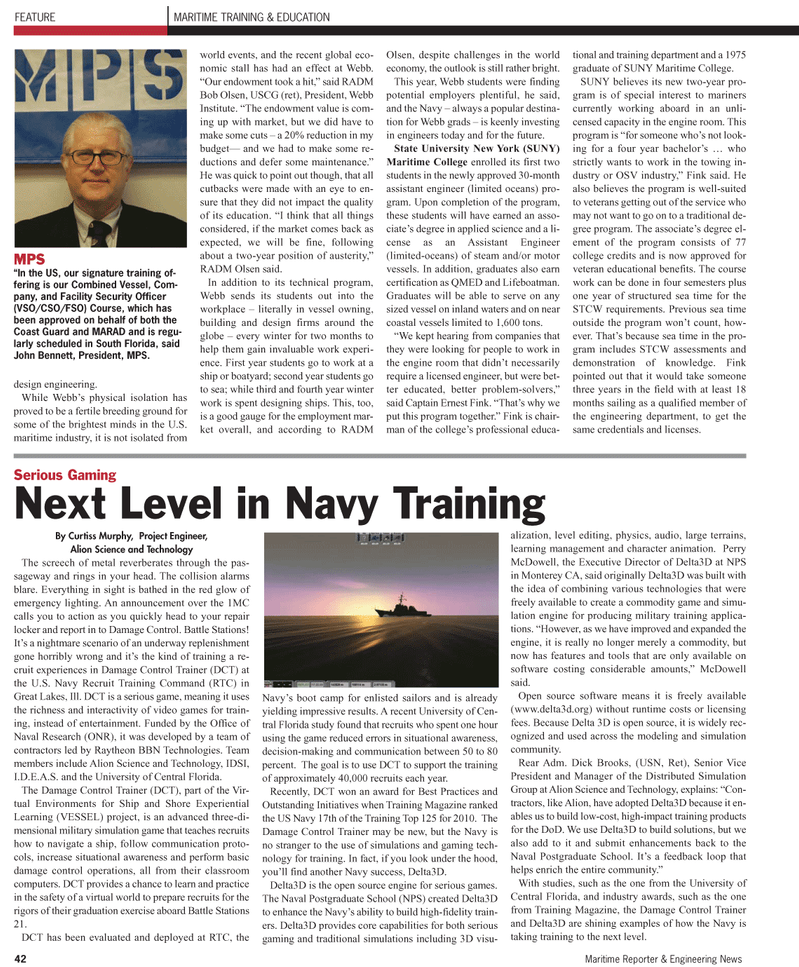
Page 42: of Maritime Reporter Magazine (May 2, 2010)
Read this page in Pdf, Flash or Html5 edition of May 2, 2010 Maritime Reporter Magazine
By Curtiss Murphy, Project Engineer,
Alion Science and Technology
The screech of metal reverberates through the pas- sageway and rings in your head. The collision alarms blare. Everything in sight is bathed in the red glow of emergency lighting. An announcement over the 1MC calls you to action as you quickly head to your repair locker and report in to Damage Control. Battle Stations!
It’s a nightmare scenario of an underway replenishment gone horribly wrong and it’s the kind of training a re- cruit experiences in Damage Control Trainer (DCT) at the U.S. Navy Recruit Training Command (RTC) in
Great Lakes, Ill. DCT is a serious game, meaning it uses the richness and interactivity of video games for train- ing, instead of entertainment. Funded by the Office of
Naval Research (ONR), it was developed by a team of contractors led by Raytheon BBN Technologies. Team members include Alion Science and Technology, IDSI,
I.D.E.A.S. and the University of Central Florida.
The Damage Control Trainer (DCT), part of the Vir- tual Environments for Ship and Shore Experiential
Learning (VESSEL) project, is an advanced three-di- mensional military simulation game that teaches recruits how to navigate a ship, follow communication proto- cols, increase situational awareness and perform basic damage control operations, all from their classroom computers. DCT provides a chance to learn and practice in the safety of a virtual world to prepare recruits for the rigors of their graduation exercise aboard Battle Stations 21.
DCT has been evaluated and deployed at RTC, the
Navy’s boot camp for enlisted sailors and is already yielding impressive results. A recent University of Cen- tral Florida study found that recruits who spent one hour using the game reduced errors in situational awareness, decision-making and communication between 50 to 80 percent. The goal is to use DCT to support the training of approximately 40,000 recruits each year.
Recently, DCT won an award for Best Practices and
Outstanding Initiatives when Training Magazine ranked the US Navy 17th of the Training Top 125 for 2010. The
Damage Control Trainer may be new, but the Navy is no stranger to the use of simulations and gaming tech- nology for training. In fact, if you look under the hood, you’ll find another Navy success, Delta3D.
Delta3D is the open source engine for serious games.
The Naval Postgraduate School (NPS) created Delta3D to enhance the Navy’s ability to build high-fidelity train- ers. Delta3D provides core capabilities for both serious gaming and traditional simulations including 3D visu- alization, level editing, physics, audio, large terrains, learning management and character animation. Perry
McDowell, the Executive Director of Delta3D at NPS in Monterey CA, said originally Delta3D was built with the idea of combining various technologies that were freely available to create a commodity game and simu- lation engine for producing military training applica- tions. “However, as we have improved and expanded the engine, it is really no longer merely a commodity, but now has features and tools that are only available on software costing considerable amounts,” McDowell said.
Open source software means it is freely available (www.delta3d.org) without runtime costs or licensing fees. Because Delta 3D is open source, it is widely rec- ognized and used across the modeling and simulation community.
Rear Adm. Dick Brooks, (USN, Ret), Senior Vice
President and Manager of the Distributed Simulation
Group at Alion Science and Technology, explains: “Con- tractors, like Alion, have adopted Delta3D because it en- ables us to build low-cost, high-impact training products for the DoD. We use Delta3D to build solutions, but we also add to it and submit enhancements back to the
Naval Postgraduate School. It’s a feedback loop that helps enrich the entire community.”
With studies, such as the one from the University of
Central Florida, and industry awards, such as the one from Training Magazine, the Damage Control Trainer and Delta3D are shining examples of how the Navy is taking training to the next level.
Serious Gaming
Next Level in Navy Training
FEATURE MARITIME TRAINING & EDUCATION design engineering.
While Webb’s physical isolation has proved to be a fertile breeding ground for some of the brightest minds in the U.S. maritime industry, it is not isolated from world events, and the recent global eco- nomic stall has had an effect at Webb. “Our endowment took a hit,” said RADM
Bob Olsen, USCG (ret), President, Webb
Institute. “The endowment value is com- ing up with market, but we did have to make some cuts – a 20% reduction in my budget— and we had to make some re- ductions and defer some maintenance.”
He was quick to point out though, that all cutbacks were made with an eye to en- sure that they did not impact the quality of its education. “I think that all things considered, if the market comes back as expected, we will be fine, following about a two-year position of austerity,”
RADM Olsen said.
In addition to its technical program,
Webb sends its students out into the workplace – literally in vessel owning, building and design firms around the globe – every winter for two months to help them gain invaluable work experi- ence. First year students go to work at a ship or boatyard; second year students go to sea; while third and fourth year winter work is spent designing ships. This, too, is a good gauge for the employment mar- ket overall, and according to RADM
Olsen, despite challenges in the world economy, the outlook is still rather bright.
This year, Webb students were finding potential employers plentiful, he said, and the Navy – always a popular destina- tion for Webb grads – is keenly investing in engineers today and for the future.
State University New York (SUNY)
Maritime College enrolled its first two students in the newly approved 30-month assistant engineer (limited oceans) pro- gram. Upon completion of the program, these students will have earned an asso- ciate’s degree in applied science and a li- cense as an Assistant Engineer (limited-oceans) of steam and/or motor vessels. In addition, graduates also earn certification as QMED and Lifeboatman.
Graduates will be able to serve on any sized vessel on inland waters and on near coastal vessels limited to 1,600 tons. “We kept hearing from companies that they were looking for people to work in the engine room that didn’t necessarily require a licensed engineer, but were bet- ter educated, better problem-solvers,” said Captain Ernest Fink. “That’s why we put this program together.” Fink is chair- man of the college’s professional educa- tional and training department and a 1975 graduate of SUNY Maritime College.
SUNY believes its new two-year pro- gram is of special interest to mariners currently working aboard in an unli- censed capacity in the engine room. This program is “for someone who’s not look- ing for a four year bachelor’s … who strictly wants to work in the towing in- dustry or OSV industry,” Fink said. He also believes the program is well-suited to veterans getting out of the service who may not want to go on to a traditional de- gree program. The associate’s degree el- ement of the program consists of 77 college credits and is now approved for veteran educational benefits. The course work can be done in four semesters plus one year of structured sea time for the
STCW requirements. Previous sea time outside the program won’t count, how- ever. That’s because sea time in the pro- gram includes STCW assessments and demonstration of knowledge. Fink pointed out that it would take someone three years in the field with at least 18 months sailing as a qualified member of the engineering department, to get the same credentials and licenses.
MPS “In the US, our signature training of- fering is our Combined Vessel, Com- pany, and Facility Security Officer (VSO/CSO/FSO) Course, which has been approved on behalf of both the
Coast Guard and MARAD and is regu- larly scheduled in South Florida, said
John Bennett, President, MPS. 42 Maritime Reporter & Engineering News

 41
41

 43
43
